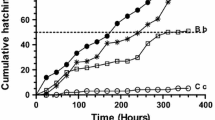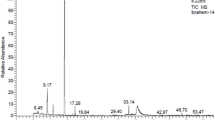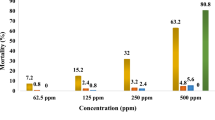Abstract
The sensitivity of larval Culicidae to vegetable tannins was investigated in different taxa representative of the fauna from alpine hydrosystems (Aedes rusticus, Culex pipiens) and foreign noxious fauna (Aedes aegypti, A. albopictus). Bioassays reveal that tannic acid at concentrations of 0.1–6 mM is significantly more toxic for C. pipiens than for Aedes taxa, and A. aegypti is more sensitive than A. albopictus and A. rusticus. Comparison of the rank order of sensitivity among taxa with the associated levels of cytochrome P-450, esterase, and glutathione-S-transferase activities suggests that cytochrome P-450 and esterases may be involved in the detoxification of tannins. A possible involvement of these detoxifying enzymes is also revealed in vivo by the synergistic effects of S,S,S-tributyl phosphorotrithioate (esterase inhibitor) and piperonyl butoxide (P-450 inhibitor). The differential sensitivity to tannins among taxa is discussed in terms of ecological implications within mosquito communities from alpine hydrosystems, where the acquisition of tannins–detoxifying enzymatic systems may be considered as a key innovation.
Similar content being viewed by others
REFERENCES
Abbott, W. S. 1925. A method of computing the effectiveness of an insecticide. J. Econ. Entomol. 18:265-267.
Ahmad, S., Brattsten, L. B., Mullin, C. A. and Yu, S. J. 1986. Enzymes involved in the metabolism of plant allelochemicals, pp. 73-151, in L. B. Brattsten and S. Ahmad (eds.), Molecular Aspects of Insect-Plant Associations. Plenum Press, New York.
Appel, H. M. 1993. Phenolic compounds in ecological interactions: the importance of oxidation. J. Chem. Ecol. 19:1521-1552.
Ayres, M. P., Clausen, T. P., Maclean, S. F., Redman, A. M., and Reichardt, P. B. 1977. Diversity of structure and antiherbivore activity in condensed tannins. Ecology 78:1696-1712.
Barbehenn, R. V., and Martin, M. M. 1994. Tannin sensitivity in larvae of Malacosoma disstria (Lepidoptera): Roles of the peritrophic envelope and midgut oxidation. J. Chem. Ecol. 20:1985-2001.
Beninger, C. W., and Abou-Zaid, M. M. 1997. Flavonol glycosides from four pine species that inhibit early instar gypsy moth (Lepidoptera: Lymantriidae) development. Biochem. System. Ecol. 25:505-512.
Berenbaum, M. R. 1983. Effects of tannins on growth and digestion in two species of papilionids. Entomol. Exp. Appl. 34:245-250.
Berenbaum, M. R. 1991. Comparative processing of allelochemicals in the Papilionidae (Lepidoptera). Arch. Insect Biochem. Physiol. 17:213-221.
Berenbaum, M. R., Favret, C., and Schuler, M. 1996. On defining “key innovations” in an adaptative radiation: Cytochrome P 450 and Papilionidae. Am. Nat. 148:S139-S155.
Bernays, E. A., Chamberlain, D. J., and Leather, E. M. 1981. Tolerance of acridids to ingested condensed tannin. J. Chem. Ecol. 7:247-256.
Bradford, M. M. 1976. A rapid and sensitive method for the quantitation of microgram quantities of protein utilizing the principles of protein-dye binding. Anal. Biochem. 72:248-254.
Brattsten, L. B. 1992. Metabolic defense against plant allelochemicals, pp. 145-242, in G. A. Rosenthal and M. R. Berenbaum (eds.). Herbivores: Their Interactions with Secondary Plant Metabolites. Academic Press, New York.
Clark, A. G. 1990. Glutathione S-transferases and resistance to insecticides, pp. 131-159, in J. D. Hayes, C. B. Pickett, and T. J. Mantle (eds.). Glutathione S-transferases and Drug Resistance. Taylor and Francis, London.
Cohen, M. B., Berenbaum, M. R., and Schuler, M. A. 1990. Immunochemical analysis of cytochrome P-450 monooxygenase diversity in the black swallowtail caterpillar, Papilio polyxenes. Insect Biochem. 20:770-783.
Cuany, A., Pralavorio, M., Pauron, D., Berge, J. B., Fournier, D., Blais, C., Lafont, R., SalaÜn, J. P., Weissbart, D., Larroque, C., and Lange, R. 1990. Characterization of microsomal oxidative activities in a wild-type and DDT resistant strain of Drosophila melanogaster. Pestic. Biochem. Physiol. 37:293-302.
Danielson, P. B., Frank, M. R., and Fogleman, J. C. 1994. Comparison of larval and adult P-450 activity levels for alkaloid metabolism in desert Drosophila. J. Chem. Ecol. 20:1893-1906.
De Veau, E. J. I., and Schultz, J. C. 1992. Reassessment of interaction between gut detergents and tannins in Lepidoptera and significance for gypsy moth larvae. J. Chem. Ecol. 18:1437-1453.
Dhillon, M. S., Mulla, M. S., and Hwang, Y. S. 1982. Allelochemical produced by the hydrophyte Myriophyllum spicatum affecting mosquitoes and midges. J. Chem. Ecol. 8:517-526.
Frank, M. R., and Fogleman, J. C. 1992. Involvement of cytochrome P450 in host-plant utilization by sonoran desert Drosophila. Proc. Natl. Acad. Sci. U.S.A. 89:11998-12002.
Gabinaud, A. 1987. Ecological mapping to support mosquito control on the French mediterranean coast. Parasitol. Today 3:317-320.
Grant, W. D. 1976. Microbial degradation of condensed tannins. Science 193:1137-1139.
Guengerich, F. P., Martin, M. V., Beaune, P. H., Kremers, P., Wolff, T., and Waxman, D. J. 1986. Characterization of rat and human liver microsomal cytochrome P 450 forms involved in nifedipine oxidation, a prototype for genetic polymorphism in oxidative drug metabolism. J. Biol. Chem. 261:5051-5060.
Habig, W. H., Pabst, M. J., and Jacoby, W. B. 1974. Glutathion-S-transferases: The first step in mercapturic acid formation. J. Biol. Chem. 249:7130-7139.
Harborne, J. B. 1982. Phytochemical Methods. Chapman and Hall, London.
Harshman, L. G., Ottea, J. A., and Hammock, B. D. 1991. Evolved environment-dependent expression of detoxification enzyme activity in Drosophila melanogaster. Evolution 45:791-795.
Harold, J. A., and Ottea, J. A. 1997. Toxicological significance of enzyme activities in profenofosresistant tobacco budworms, Heliothis virescens (F.). Pestic. Biochem. Physiol. 58:23-33.
Karoly, E. D., Rose, R. L., Thompson, D. M., Hodgson, E., Rock, G. C., and Roe, R. M. 1996. Monooxygenase, esterase, and glutathione transferase activity associated with azinphomethyl resistance in the tufted apple bud moth, Platynota idaeusalis. Pestic. Biochem. Physiol. 55:109-121.
Larroque, C., Lange, R., Bomfils, C., and van Lier, J. E. 1988. Stéréospécificité de I'hydroxylation des stéroïdes par les cytochrome P 450: Nécessité biologique ou conséquence de leur multiplicité, pp. 269, in J. B. Beck and A. Craste de Paulet (eds.). Activités Biologiques des Oxystérols. Colloque INSERM.
Lee, K. 1991. Glutathione-S-transferases in phytophagous insects: induction and inhibition by plant secondary compounds. Insect Biochem. 21:353-361.
Leszczynski, B., Matok, M., and Dixon, A. F. G. 1994. Detoxification of cereal plant allelochemicals by aphids: activity and molecular weights of glutathione-S-transferase in three species of cereal aphids. J. Chem. Ecol. 20:387-394.
Lineweaver, H., and Burk, D. 1934. The determination of enzyme dissociation constants. J. Am. Chem. Soc. 56:658-666.
Mercer, D. R., and Anderson, J. R. 1994. Tannins in treehole habitats and their effects on Aedes sierrensis (Diptera: Culicidae) production and parasitism by Lambornella clarcki (Ciliophora: Tetrahymenidae). Ann. Entomol. Soc. Am. 31:159-167.
Motayama, N., Nishizawa, Y., Nagakura, A., Takemasa, T., and Dautermam, J. 1991. Selective inhibition of the cytochrome P450-dependent monooxygenases from the rat liver and housefly abdomen. Pestic. Future 1:173-184.
Mourya, D. T., Hemingway, J., and Leake, C. J. 1993. Changes in enzyme titres with age in four geographical strains of Aedes aegypti and their association with insecticide resistance. Med. Vet. Entomol. 4:11-16.
Nelson, D. R., Kamataki, T., Waxman, D. J., Guengerich, F. P., Estabrook, R. W., Feyereisen, R., Gonzalez, F. J., Coon, M. J., Gunsalus, I. C., Gotoh, O., Okuda, K., and Nebert, D. W. 1993. The P450 superfamily: Update on new sequences, gene mapping, accession numbers, early trivial names of enzymes and nomenclature. DNA Cell Biol. 12:1-51.
Paradise, C. J., and Dunson, W. A. 1997. Insect species interactions and resource effects in treeholes: are helodid beetles bottom-up facilitators of midge populations? Oecologia 109:303-312.
Pautou, G. 1981. Les milieux aquatiques de lisière dans la vallée du Rhône en amont de Lyon. Détection des populations animales liées aux milieux inondés périodiquement: L'exemple des Culicidés. Rapport pour le Ministère de l'Environnement-Comité Faune-Flore II:1-16.
Pautou, G., AÏn, G., Gilot, B., Cousserans, J., Gabinaud, A., and Simonneau, P. 1973. Cartographie écologique appliquée à la démoustication. Doc. Cartog. Ecol., Univ. Sci. Med. Grenoble, France 11:1-16.
Provost, M. W. 1975. Needle rush as an indicator of breeding of salt-marsh mosquitoes. Ann. Proc. Fla. Anti-mosq. Contr. Assoc. 46:23-28.
Raymond, M., 1985. Présentation d'un programme basic d'analyse log-probit pour micro-ordinateur. Cah. O.R.S.T.O.M., Ser. Entomol. Med. Parasitol. 23:117-121.
Rey, D., Marigo, G., and Pautou, M. P. 1996. Composés phénoliques chez Alnus glutinosa et contrôle des populations larvaires de Culicidae. C.R. Acad. Sci. Paris, Sci. Vie 319:1035-1042.
Rey, D., Pautou, M. P., and Meyran, J. C. 1999. Histopathological effects of tannins on the midgut epithelium of aquatic Diptera larvae. J. Invertebr. Pathol. In press.
Rioux, J. A., Croset, H., Corre, J. J., Simonneau, P., and Gras, G. 1968. Phyto-ecological basis of mosquito control: Cartography of larval biotopes. Mosquito News 28:572-582.
Scott, J. A., Colins, F. H., and Feyereisen, R. 1994. Diversity of cytochrome P 450 genes in the mosquito, Anopheles albimanus. Biochem. Biophys. Res. Commun. 205:1452-1459.
Smirle, M. J., Lowery, D. T., and Zurowski, C. I. 1996. Influence of neem oil on detoxification enzyme activity in the oblique banded leafroller, Choristoneura rosaceana. Pestic. Biochem. Physiol. 56:220-203.
Sota, T. 1993. Performance of Aedes albopictus and A. riversi larvae (Diptera: Culicidae) in waters that contain tannic acid and decaying leaves: Is the treehole species better adapted to treehole water? Ann. Entomol. Soc. Am. 86:450-457.
Swain, T. 1979. Phenolics in the environment. Recent Adv. Phytochem. 12:617-640.
Tellier, X., Steffan, J., and Buhlmann, A. 1991. Mécanismes d'apparition des phénomènes de résistance aux insecticides et acaricides: Conséquences pratiques. Rev. Med. Vet. 142:657-667.
Towers, G. H. N., Neish, A. C., Brown, S. A., and Conn, E. E. 1964. Biochemistry of Phenolic Compounds. J. B. Harborne (ed.). Academic Press, New York.
Ulrich, V., and Weber, P. 1972. The O-dealkylation of 7-ethoxycoumarin by liver microsomes. A direct fluorimetric test. Hoppe-Seyler's Z. Physiol. Chem. 353:1171-1177.
Van Asperen, K. 1962. A study of housefly esterases by means of a sensitive colorimetric method. J. Insect Physiol. 8:401-408.
Wadliegh, R. W., and Yu, S. 1988. Detoxification of isothiocyanate allelochemicals by glutathione transferase in three lepiddopterous species. J. Chem. Ecol. 14:1279-1288.
Waxman, D. J., Ko, A., and Walsh, C. 1983. Regioselectivity and stereoselectivity of androgen hydroxylations catalyzed by cytochrome P 450 isozymes purified from phenobarbital-induced rat liver. J. Biol. Chem. 258:11937-11941.
Waxman, D. J., Dannan, G. A., and Guengerich, F. P. 1985. Regulation of rat hepatic cytochrome P450: Age dependent expression, hormonal imprinting and xenobiotic inducibility of sex specific isoenzymes. Biochemistry 24:4409-4417.
Yu, S. J. 1987. Microsomal oxidation of allelochemicals in generalist (Spodoptera frugiperla) and semispecialist (Anticarsia gemmatalis) insect. J. Chem. Ecol. 13:422-436.
Yuan, J., and Chambers, H. W. 1996. Toxicology and biochemistry of two aliesterase inhibitors as synergists of four organophosphorus insecticides in boll weevils (Coleoptera: Curculionidae). Pestic. Biochem. Physiol. 54:210-219.
Author information
Authors and Affiliations
Rights and permissions
About this article
Cite this article
Rey, D., Cuany, A., Pautou, MP. et al. Differential Sensitivity of Mosquito Taxa to Vegetable Tannins. J Chem Ecol 25, 537–548 (1999). https://doi.org/10.1023/A:1020953804114
Issue Date:
DOI: https://doi.org/10.1023/A:1020953804114




